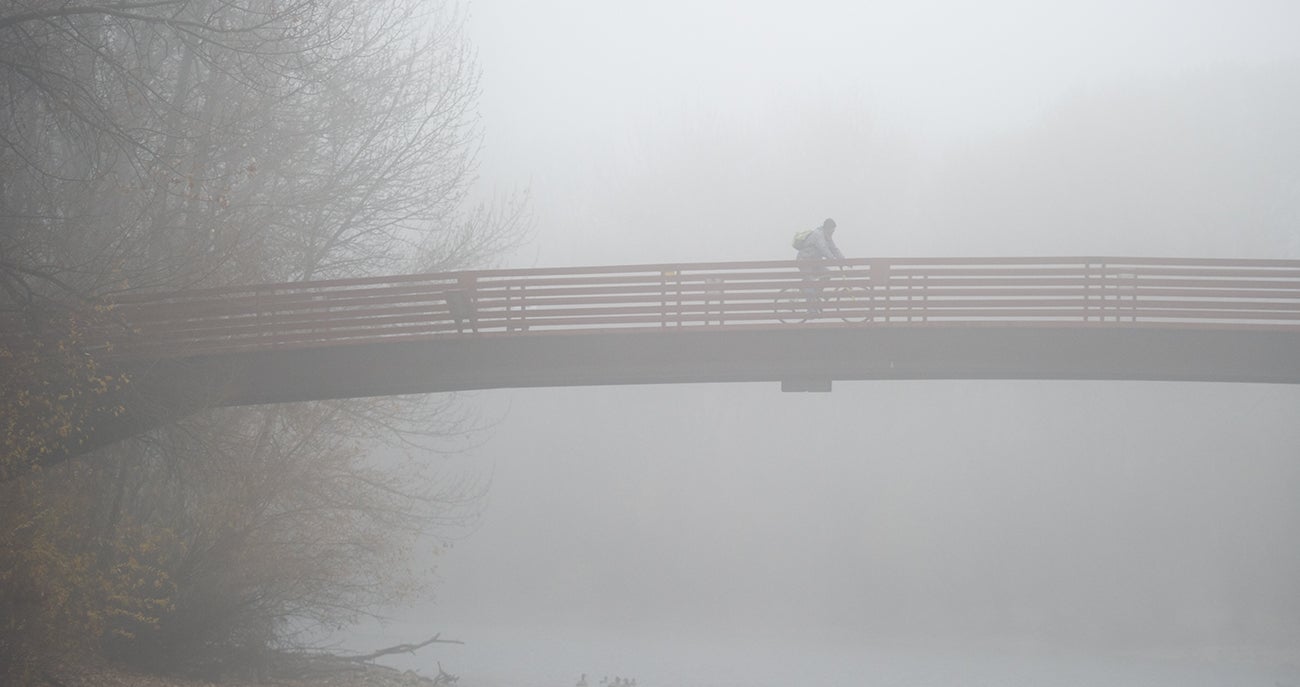
Fall has fallen and the leaves are turning neat colors. In Boise, that means things are about to get CHILLY. If you’re like me and you bike to or around campus every day, you might be wondering if you should store that bicycle until it warms up again. To that, I say nay. Biking in cold weather has benefits you wouldn’t think of.
- Feeling extreme. That’s right. Pat yourself on the back – gently ‘cuz your fingers are a little stiff – when you pull up to your frost-coated building on two wheels
- You get bike lanes and the Greenbelt almost all to yourself
- You get exercise
But how can I bike comfortably when it sucks outside, you ask? By investing in particular gear. There are cheaper ways and more expensive ways to do it, but either way pays for itself in the long run.
Gear options: What to use
The main goal of having the right gear is to be able to transport you and your stuff from A to B without getting soaked.
- Fenders
- Waterproof backpack
- Bike cargo rack
- Waterproof pannier
- Sweet bike
Here’s what I have: I leave my fenders on year-round because I’m too lazy to take them off and they are sooo nice to have when you’re riding on wet surfaces. I have a waterproof pannier that I can easily clip on and off my cargo rack that I bought at the Cycle Learning Center.
Clothing options: What to wear
It’s tempting to throw on the biggest warmest coat you have when it’s cold outside, but when you’re on a bike, you can’t get too hot underneath or you’ll start sweating. It’s a difficult balancing act, so it might take some experimenting to find out what works best for you.
Torso options
Leave that big puffy coat at home and consider a thinner jacket that blocks the wind and has some ventilation.
- Windbreaker
- Jacket
- Raincoat
- Base layer
Here’s what I do: When it’s not freezing, I wear a normal cotton jacket. When it’s freezing, I wear a base layer – sometimes thermals, sometimes cotton – and then I wear a thin ski jacket that does a good job protecting against both wind and water/snow. I do this pretty much all winter under the most freezing conditions and it works really well.
Head options
I sometimes see people without anything on their head and face in the cold and think to myself, well, they’re probably never going to do that again.
- Balaclava
- Helmet liner
- Stocking cap
- Scarf
- Glasses/goggles
Here’s what I do: When it’s not freezing, I wear a beanie under my helmet and some sunglasses. When it’s freezing, I wear a balaclava and a ski mask. Cold wind against your eyes is a terrible feeling, but with that combination – your head is warm as can be.
Hands options
Your hands are probably the most sensitive to the cold, so it’s important to keep them as comfortable as possible.
- 5 fingered gloves
- Lobster gloves
Here’s what I do: I wear normal gloves when it’s just a little cold. When it’s freezing, I wear lobster gloves that are kind of a mix between mittens and 5 finger gloves – they are a lot warmer. They’re good at protecting against wind chill, but if it’s really cold out, drop some hand warmers in there for maximum warmth. Seriously, lobster gloves are amazing.
Legs and feet options
- Leg warmers
- Long johns
- Rain pants
- Thick non-cotton socks
- Overshoe booty
There are a lot of options for this one. Sometimes just a pair of jeans is enough – other times you need snow pants.
Here’s what I do: Most times I just wear a pair of pants with a base layer underneath. I also wear long, thick socks and a shoe that doesn’t let wind in. I also bring with me a pair of rain pants on cloudy days.
Check out the Cycle Learning Center website for more tips on winter riding.
By Mike Taylor